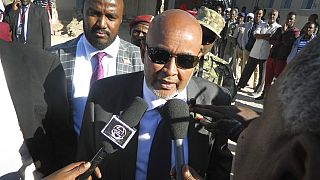Somalia
At Turkaraq – a village in Somalia’s semi-autonomous Puntland region, a group of pastoralists have set up camp. They travelled long distances in search of water and pasture.
While movement is part of life for Somalia’s pastoralists – in the last year, they have struggled to find water and viable grazing land for their animals due to failed rains.
“I am 75 years old, I have not heard of or seen such a severe drought,” said Bile Abdi.
Bile’s family say they travelled up to 150 kilometres to get here with 1,200 goats and sheep. Only 60 goats and sheep survived.
His grandson died along the way.
Five million Somalis do not have enough to eat according to the United Nations. The drought has led to poor harvests and livestock deaths and fears of a period of severe hunger are rippling through the region, including in neighboring Kenya and Ethiopia.
“This drought is different from the previous droughts. People from all over do not have anywhere to escape to and some came here,” said Abdi.
Aid agencies say Somalia is at risk of a repeat of the famine that killed nearly 260,000 people in 2011 if aid is not stepped up over the next two months.
Initial forecasts are predicting a third consecutive poor rainy season in April.
In 2011 the humanitarian response was too slow and tens of thousands of people died before the famine was officially declared in July.
This time preparations started early, with two drought warnings and a pre-famine alert issued over the past 12 months, but the UN says more funds are needed.
However, The World Food Programme (WFP) warns the current drought is more extensive than in 2011.
“People are leaving part of their families behind because they are too weak to move. They are coming here and what I saw also is that people are sharing their food with the animals and with their camels,” said Pedram Yazdi, an ICRC officer.
In Tukaraq village the pastoralists found some relief thanks to the local community. Villagers have shared their water and resources with the herders but even that is scarce and the hosts are now also in need of assistance.
“We are alive because they (the hosts) gave us water and anything they could help us with,” said Abdi.
The International Committee of the Red Cross (ICRC) began a series of food distributions this month, starting in locations across northern Somalia that will continue to the South-Central, including in areas affected by conflict.
African Union and Somali troops have driven al Shabaab from major urban strongholds and ports, but they have often struggled to defend smaller, more remote areas from attacks.
“We will carry on to the end of the month and we’ll cover 36 areas. Places where there are the destitute, host communities and vulnerable people who don’t have food,” said Ahmed Artan, an ICRC field officer.
ICRC say they are distributing food, cash and other essential items to 240,000 people affected by the drought in Somalia.
Agencies say humanitarian access to the al Shabaab strongholds of Lower and Middle Juba regions remains limited, with satellites monitoring rainfall trends showing those areas to be “the most worrying in all of Somalia”.












01:40
Zimbabwe farmers turn to maggot-breeding to survive the drought
01:27
Activists highlight plight of world's hungry ahead of G20 summit in Brazil
01:00
Somaliland counts votes after pivotal election
01:26
Zimbabwe’s Climate-Smart Agriculture: Empowering Farmers through Resilience and Innovation
01:40
UN report warns of famine, aggravated by conflicts and climate shocks
01:26
UN: Southern Africa faces worst hunger crisis in decades due to El Niño